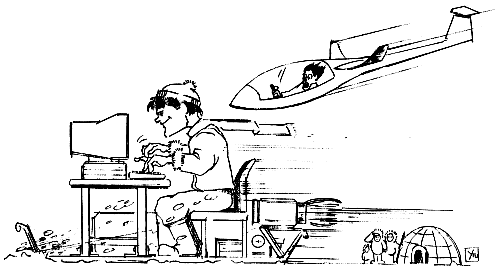

Polar Explorer
CuSoft Polar Explorer
Some 10 years ago I wrote a program for DOS named "Polar Explorer", designed for analyzing both theoretical and practical aspects of glider performance in any conditions. The program was advertised in the Soaring magazine for a couple of years by CuSoft Research Inc., and some 30 odd copies sold for US$ 99 each.

For those still interested in this program, you can now download the fully functional Polar Explorer Version 2.2 for free.
Note: Polar Explorer 2.2 comes with a library of around 150 measured polars, however, this library includes only the gliders for which data was available back in 1993. In order to make the program more useful, the polars of additional gliders (especially the newer ones) should be added. If you go through the trouble of entering one or more new polars into Polar Explorer, please email me at info@trimill.com a copy of the glider library containing the new polars, along with the references to the source you used. I will review and compile these new polars into a separate glider library, which I will make available for download on this page.
See also:
For any questions and comments, please email me at info@trimill.com
Downloads
| Polar Explorer 2.2 program & support files | Polar_Explorer_22.zip |
| Polar Explorer 2.2 Short User's Guide | Polar_Explorer_Short_Guide.pdf |
| Generalized Speed-To-Fly Theory paper | Generalized_STF_Theory.pdf |
Short Description
To install Polar Explorer, simply unzip the contents of Polar_Explorer_22.zip file to a new folder on your hard drive and place a shortcut to the PE22.EXE file on your desktop. That should do it.
Polar Explorer is a DOS program that you can run in a DOS window under all versions of Windows. Note that you have to be in a full screen mode in order to switch to the graphics display (unless you are using the DOSBox program). See the FAQ page and Polar Explorer's short user's guide for additional instructions.
Polar Explorer is designed to answer many specific questions about glider performance. As a result, you can use it for many different purposes. The following are a few examples of what you can do:
-
Complement the books and articles on glider performance and soaring tactics by working out practical examples.
-
Find out the optimum circling technique for any glider at any altitude and wing loading.
-
Calculate climb performance in thermals of different strength and shape.
-
Plan and analyze cross-country flights and final glides.
-
Optimize configuration (i.e. short/long wing span or winglets) and wing loading for any weather conditions.
-
Apply generalized speed-to-fly theory to maximize cross-country performance when using ridge lift or waves. Although the Polar Explorer tutorial explains the basics of this theory, you can also download a scanned version of the original Generalized Speed-To-Fly Theory paper I published in 1991. Polar Explorer uses the equations published in this paper in computing the speed-to-fly and the average cross-country speed.
-
Compare circling and cross-country performances in addition to comparing polars.
-
Design and test speed rings and final glide computers, for any altitude and wing loading.
-
Enter and analyze any glider polar that you come across. The glider polar library that comes with the program already contains 150 polars (see below).
-
If you are contemplating any modifications to your sailplane (e.g. adding winglets), you can use Polar Explorer's advanced features to estimate the performance gains.
-
Calculate more realistic handicap factors based on the cross-country performance for the expected or actual weather conditions.
Copyright © Trimill